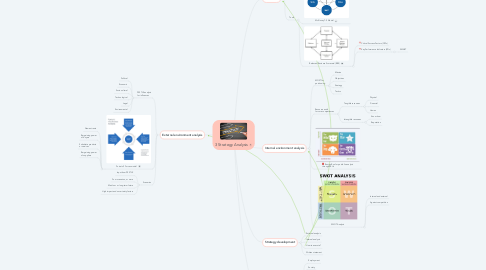
1. Strategy development
1.1. External analysis
1.2. Internal analysis
1.3. How to execute?
1.4. Written statement
2. External environment analysis
2.1. PESTLE analysis for influences
2.1.1. Political
2.1.2. Economic
2.1.3. Socio-cultural
2.1.4. Technological
2.1.5. Legal
2.1.6. Environmental
2.2. Porter's 5 Forces model
2.2.1. New entrants
2.2.2. Bargaining power of buyers
2.2.3. Substitute products or services
2.2.4. Bargaining power of suppliers
2.3. Scenarios
2.3.1. Input from PESTLE
2.3.2. Four scenarios, or more
2.3.3. Medium- or long-term future
2.3.4. High impact and uncertainty factors
3. Internal environment analysis
3.1. MOST for positioning
3.1.1. Mission
3.1.2. Objectives
3.1.3. Strategy
3.1.4. Tactics
3.2. Resource audit for core competences
3.2.1. Tangible resources
3.2.1.1. Physical
3.2.1.2. Financial
3.2.1.3. Human
3.2.2. Intangible resources
3.2.2.1. Know-how
3.2.2.2. Reputation
3.3. Boston Box for portfolio analysis through SBUs
3.4. SWOT Analysis
3.4.1. Internal and external
3.4.2. Against competition
4. Executing
4.1. Context
4.1.1. Time
4.1.2. Scope
4.1.3. Capability
4.1.4. Readiness
4.1.5. Strategic leadership
4.2. Role of the leader
4.3. Tools
4.3.1. McKinsey 7-S Model
4.3.2. Balanced Business Scorecard (BBS)
4.3.2.1. Critical Success Factors (CSFs)
4.3.2.2. Key Performance Indicators (KPIs)
4.3.2.2.1. SMART
5. Strategy
5.1. Context
5.1.1. Employment
5.1.2. Society
5.1.3. Organization
5.1.4. Contradictions
5.1.4.1. Global versus local
5.1.4.2. Centralized versus decentralized
5.1.4.3. Hard and soft management
5.2. Concept
5.2.1. Goal of mission
5.2.2. Time frame
5.2.3. Organization of resources
5.2.4. Environment
5.3. Levels of strategy
5.3.1. Corporate
5.3.2. Business Unit
5.3.3. Operational
